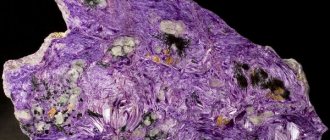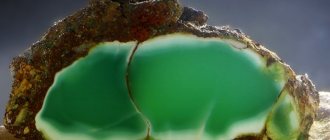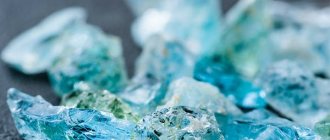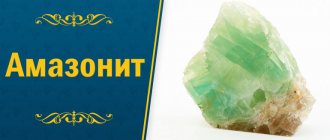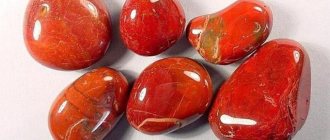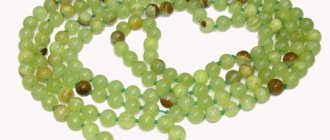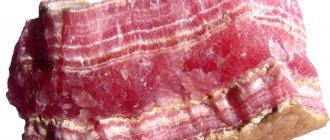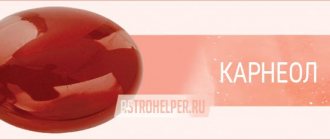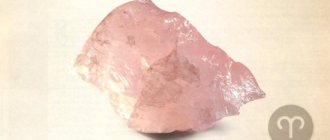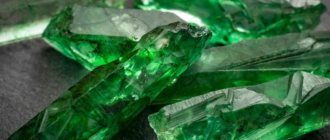The name "chalcedony" does not belong to one specific stone, but combines several varieties of opaque semi-precious stones.
Fiberstones are varieties of quartz and come in different colors, patterns, textures and inclusions, but remain similar in chemical composition and physical properties. The stone chalcedony is named after the place in Asia Minor where it was mined. Precious varieties of chalcedony include blue pseudosapphire, light green chrysoprase and blood red carnelian.
Origin and history of deposits
Chalcedony has been mined since biblical times. The first mention of this amazing stone is contained in the New Testament. The writings of John the Theologian mention that chalcedony was one of the elements of the wall of the heavenly city of Jerusalem.
In ancient times, vessels, weapons, statues were made from it, and clothes were decorated. Brooches, pendants and rings made from this mineral were also extremely popular. Manuscripts of ancient scientists and doctors contain descriptions of the healing properties of chalcedony, which was used to treat many diseases. Interest in stone increased in the Middle Ages.
Every fashionista had earrings and necklaces made of chalcedony in her box. It has gained wide popularity as an ornamental stone. In the 20th century, this mineral became the favorite jewelry treasure of the Russian intelligentsia.
Chalcedony is mined mainly in the USA, Scotland, Canada, Uruguay, India and Madagascar. The gemstone is also mined in Russia in Eastern Siberia and Chukotka.
Links[edit]
- Duda, Rudolf; Rail, Lubos (1990). Minerals of the World
. Arch Cape Press. - ^ab Heaney, Peter J. (1994). "Structure and chemistry of low-pressure silica polymorphs". In Heaney, P.J.; Prewitt, C.T.; Gibbs, G.W. (ed.). Silica: physical behavior, geochemistry and materials
.
Reviews in Mineralogy. 29
. pp. 1–40. - ^ ab "Gemological information on chalcedony". International Gem Society (IGS). Archived from the original on February 7, 2015. Retrieved January 16, 2015.
- Zwierlein-Diehl, Erika (2007). Antike Gemmen und ihr Nachleben. Berlin: Verlag Walter de Gruyter. P. 307. According to the OED, the connection with the city of Chalcedon is “very doubtful”: Harper, Douglas. "Chalcedony". Online Dictionary of Etymology
. - ↑
Pliny the Elder.
"Chapter 7". Naturalis Historiae
. Book 37. p. 115. - James Orr, ed. (1915). "Chalcedon". International Standard Bible Encyclopedia
. Howard-Severance Company. item 2859. - CIBJO Member Laboratories (May 2009). "Retailer's Reference Guide: Diamonds, Gemstones, Pearls and Precious Metals". Bern, Switzerland: CIBJO (World Jewelry Federation, international federation of all national trade organizations and gemological laboratories).
- Smith, M. (2006). "Characterization of Late Pleistocene and Holocene lithic artefact assemblages from the Purityarra rockshelter: a long sequence from the Australian desert" (PDF). Records of the Australian Museum
.
Australian Museum. 58
(3):371–410. DOI: 10.3853/J.0067-1975.58.2006.1470. S2CID 86522736. - Smith, Mike (2013). Archeology of the Australian Deserts
. paragraph 295. - Jump up
↑ Hogan, C. Michael (2007). "Knossos Field Notes". Modern antique. Archived from the original on April 9, 2016. - Section 12 on the translation of Weilue
- in the third century Chinese text by John Hill under "carnelian" and note 12.12 (17) A. Also see Afghan Exhibition: Intaglio with griffin, Chalcedony, 4th century BC, Afghanistan. Archived February 25, 2012, at the Wayback Machine. - ^ ab Streeter, Edwin (1898). Precious stones and precious stones
. paragraph 237. - "Chalcedony Minerals Information and Data". www.mindat.org
. Archived from the original on August 21, 2006. - ^ab Heaney, Peter J.; Post, Jeffrey E. (January 24, 1992). "Widespread occurrence of a new silica polymorph in microcrystalline quartz species". The science
.
New episode. 255
(5043):441–443. DOI: 10.1126/science.255.5043.441. JSTOR 2876012. PMID 17842895. S2CID 32497622. - Origlieri, Marcus (January 1994). "Moganite: a new mineral - no!" . Lithosphere
. Archived from the original on March 9, 2008. - Nickel, Ernest H.; Nichols, Monte K. (May 16, 2008). "List of IMA/CNMNC mineral names" (PDF). Materials data
. Archived from the original (PDF) on May 30, 2008. Retrieved June 29, 2008. >
Physical properties of chalcedony
All stones belonging to the chalcedony group have the following common physical properties:
- Hardness - 6.5 - 7 units;
- Density is 2.6 g/cm3;
- Impurities: iron, water, magnesium, calcium, aluminum;
- Gloss: waxy, smoky;
- Fragile;
- Transparent;
- Acid resistance;
- Form of discharge: similar to stalagmites and stalactites, kidney-shaped, nodules, shells.
- Colored varieties belong to the group of semi-precious stones.
The composition is dominated by quartz and moganite, formed as a result of the fusion and subsequent crystallization of silica. The class of minerals is oxides.
Geochemistry [edit]
chalcedony mouse, Avenir Sumin
Structure [edit]
Chalcedony was once thought to be a fibrous variety of cryptocrystalline quartz. [13] However, it has recently been shown to also contain a monoclinic quartz polymorph known as moganite. [2] The mass fraction of moganite in a typical chalcedony sample can vary from less than 5% to more than 20%. [14] The existence of moganite was once considered doubtful, but is now officially recognized by the International Mineralogical Association. [15] [16]
Solubility[edit]
Chalcedony is more soluble than quartz at low temperatures, even though the two minerals are chemically identical. This is thought to be due to the fact that chalcedony is extremely fine-grained (cryptocrystalline) and therefore has a very high surface area to volume ratio. [ citation needed
] It has also been suggested that the higher solubility is due to the moganite component. [14]
Solubility of quartz and chalcedony in pure water[edit]
This table shows the equilibrium concentrations of total dissolved silicon calculated using PHREEQC
(PH REdox EQuilibrium (in C, USGS)) using the llnl.dat database.
[ citation needed
]
| Temperature | Quartz solubility (mg/l) | Chalcedony solubility (mg/l) |
| 0.01°C | 0,68 | 1,34 |
| 25.0°C | 2,64 | 4,92 |
| 50.0°C | 6,95 | 12,35 |
| 75.0°C | 14.21 | 24,23 |
| 100.0°C | 24,59 | 40,44 |
Varieties and colors of chalcedony
Depending on the type of stone, chalcedony can be painted in different colors: reddish, brown, emerald, white, honey, bluish and ocher tones. The chalcedony group includes many stones, many of which have long been known to man.
Agate
Agate consists of layers of thin fibers of various colors, with varying degrees of transparency and density. Other modifications of silica are often present, such as quartz, quartzite, moganite, and opal. Due to its layering or specific pattern, agate has several types:
- in the form of a bastion - cracks and layers create the illusion of a cityscape or the ruins of a bastion;
- Brazilian - with thin layers 1.5 micrometers thick;
- tree-like (dendritic) - with a forest pattern;
- discoid;
- star-shaped;
- mossy - inclusions of impurities create a unique pattern in the form of moss.
According to legend, agate , which has a blue, indigo or violet color, is the eye of a white eagle defeated by a black sorcerer. It is also known as the "Eye of the Creator" - the eye that can distinguish between the good and bad things we do.
Fire Agate is a red-orange opaque layered gemstone with vibrant flecks of limonite. This agate is also called Mexican agate because it is found only in northern Mexico and the southwestern US state of Arizona.
Variety of varieties
The basis of the composition of chalcedony is silicon oxide. It also contains various metallic impurities, the ratio of which determines the color of a particular specimen. By looking at a photo of chalcedony, anyone can see how different one sample can be from another. Based on external factors, mineralists have identified the following varieties of the mineral:
Carnelian, also known as carnelian (from the Latin - “dogwood berry”). This subspecies of stone received this name due to its bright reddish or, rather, orange tint due to the iron impurity. In different specimens, a yellow, red or brown undertone predominates - this depends on the amount of time that a particular specimen spent in the open sun: exposure to ultraviolet rays causes the stone to lighten.
Sardonyx, a darker, richer variety of carnelian, shaped like a trefoil. Ancient Egyptian symbol of Isis, mother of the gods. It was believed that a talisman made from this mineral would help stop bleeding as quickly as possible and protect against the wrath of enemies.
Sarder. Essentially the same carnelian, with a bias towards brown shades. The ancient technology of its manufacture was described in the 1st century. BC Pliny: sarder was prepared by boiling light chalcedony in a honey solution or roasting.
Onyx is a variant of chalcedony that has a ribbon structure and pronounced layering. Typically has a red or white base with yellow, pink or brown stripes. It is being developed in Saudi Arabia and India, and is also available in the USA, South America and the Russian Far East.
Chrysoprase, a variety of chalcedony especially valued by jewelers for its color, is in turn divided into three subtypes: emerald green, apple green, and pale-colored turquoise or yellowish-green varieties.
Sapphirine. Bluish chalcedony that fades when exposed to heat.
Heliotrope. An exotic-looking variety of chalcedony, often also called bloodstone or bloody jasper. It has a green base intersected by bright red stripes. Heliotrope is very popular among collectors and jewelers. Most often, this stone is used as an insert in men's rings. In the Middle Ages, church items were made from stone; the mineral had a sacred meaning, since red blotches on its surface were associated with the blood of Christ.
Agate. Layered mineral of various colors. Jewelers often classify stones as agates that do not have a layered structure, but a star-shaped or mossy structure. An ancient legend says that the agate was lost by the White Eagle during the battle with the Black Eye Sorcerer. It is also called the Eye of the Creator, observing human actions and dividing them into good and evil.
Heliotrope, flint and jasper
All these varieties of gemstones are very similar in appearance to chalcedony. However, not all experts consider them as such. Not everyone can distinguish agate from jasper. The only difference is that jasper is not transparent at the edges, but may only be slightly translucent. Under a microscope you can find jasper agates that are partially translucent. But you can see through the agate.
Jasper can range in color from pale yellow to rich gold, with an unusual swirl pattern. But there is another variety of it - bloody jasper or heliotrope . It can be dark red or dark green, with bloody streaks, and may have yellow spots. In the Middle Ages it was often used to make church vessels.
Cacholong
cacholong chalcedony species is usually described as a porous, milky white chalcedony, reminiscent of porcelain or milky opal. It is a mixture of opal and chalcedony. Since the first and second silica are combined with quartz, the mutual penetration of the elements creates interesting, unusually beautiful stones.
Moss agate
A fascinating work of nature, interspersed with dendrites or fibrous inclusions of manganese, nickel or iron. Celadonite (milk opal) can also be classified as a type of moss agate. As a result of inclusions of iron from gray, blue-gray or milky white chalcedony, floral landscapes are obtained in which you can see trees, mosses or algae. They are easy to spot because they vary in color: red and reddish, black and green, gray and brown, yellow and yellowish-white.
Mtorolite (chrome chalcedony)
This stone is similar to chrysoprase, but may have tiny black chromite flecks in its texture. In the ancient world, mtorolite was well known to jewelers, but was subsequently forgotten. It was only in the 1950s, after the development of deposits in Zimbabwe, that the mineral regained its importance for jewelers. The modern name comes from the city of Mtoroshanga, where the stone was mined.
Onyx chalcedony
This is a banded decorative and ornamental gemstone. It is characterized by alternating bands of chalcedony itself, quartz and other silicas. Hence the bright white-pink, red-brown, white-brown, red-black stripes. Onyx is a type of layered agate. Jewelers also call onyx almost black chalcedony, in which the layers can only be seen under a microscope. The mineral is transparent or translucent. The beauty of onyx is best seen in cameos and intaglios.
Sapphire
This is the trade name for blue or light blue chalcedony (in mineralogy this term has a different meaning). Sapphire is a rare translucent mineral. Tends to fade at high temperatures.
Red chalcedony (sardonyx, carnelian)
Mineral in shades of red. Sardonyx and carnelian are examples that are predominantly shades of brown, orange-brown, red-brown. Sardonyx is a striped red chalcedony. The predominant color in carnelian is red interspersed with yellow and brown. In the sun, the color becomes more saturated: shades of brown instantly turn orange.
Chrysoprase
This variety is valued for its color: an admixture of nickel makes the mineral light green or bluish-green, and chromium gives it a greenish tint. It can fade in the sun (to restore color, it is better to wrap the stone in a damp cloth). Jewelers who praise chrysoprase divide it into three varieties:
Faceted chrysoprase
- The highest is a uniform and rich emerald green color with transparency reaching 5 cm;
- The first grade includes a homogeneous apple-green, transparent stone, possibly having whitish and opaque areas;
- The second type (or second grade) is a brightly spotted mineral, which is a decorative stone that may contain transparent or opaque areas with blue-green or yellow-green hues.
Enhydros (water agate)
Transparent minerals containing chalcedony, quartz and lutenite. The cavity of each such mineral contains water, which is several million years old. Engidros is valued not only by jewelers, but also by yoga and feng shui practitioners. These stones are able to purify water much faster than other minerals.
Pink chalcedony
Pink chalcedony is known among the Mongols as a stone that brings joy. It owes its pink-red hue to an admixture of iron oxide (hematite). The most popular variety is carnelian. Its shade can be different, even scarlet. There are also striped specimens with lighter areas.
The shine and poverty of chalcedony
Chalcedony (like jade, rock crystal, jadeite, flint, obsidian) is found by archaeologists in amulets and jewelry of ancient people. And not just decorations. In museums you can see chalcedony knives discovered by archaeologists during excavations of Paleolithic sites.
Chalcedony knife, 1200-1000 BC
Green chalcedony portrait bust of Julia Drusilla or Livia Livilla (sister of Caligula), made around 37-39 AD, British Museum
- The gem “participated” in the construction of the walls of the Heavenly City (according to the Bible).
- Painted stone has been found in Egyptian tombs.
- Pliny in his Natural History described the varieties of chalcedony.
- The first wave of popularity of the gem occurred in Antiquity. The ancient Greeks were unsurpassed stone cutters. The art of glyptics (stone carving) in those days reached unprecedented heights. And the structure of multi-layered varieties of chalcedony made it possible to turn stones into true works of art.
- With the collapse of the Roman Empire, cultural values disappeared and interest in the wonderful stone disappeared.
- Chalcedony is mentioned in the works of G. Agricola.
- The second wave of “chalcedony fever” covered the 17th-19th centuries. Classicism came into fashion, and interest in ancient culture was revived. A rich layer of citizens enthusiastically decorated their homes with mosaics, furniture inlaid with colored stones, figurines, vases and other cute little things. Lovers and connoisseurs of antiquities traveled to Italy not only to bask in the sun, but also to expand their collections of antique jewelry.
- Some of them now decorate the halls of the Hermitage, Louvre and other lucky owners.
origin of name
We read from Bukanov:
“The old Russian name for chalcedony is perelift.” And again the Urals make us happy. Here you can find a special variety of agate - iridescence, in which the layers of chalcedony seem to “flow” in bizarre streams and stripes, and the color shimmers from white to bluish and yellowish-orange, reddish.
Versions of the origin of the name of the mineral:
- From the city of Kalchedon (Chalcedon) . At that time it belonged to Greece. Now territorially belongs to Turkey (Kadikoy district of Istanbul).
- From Carchedon (Carthage) . It was a port in North Africa. The stone was mined in Egypt and Syria, and from there it was delivered to Carthage. From the port, boats transported the gem throughout the Ecumene.
Striped Chalcedony
Among the most interesting varieties of chalcedony are the striped varieties. These include:
Agate is a layered, patterned mineral that can contain many different colors. Depending on the type of pattern, agates can be Brazilian, dendritic, moss, star-shaped, disc-shaped or bastion-shaped.
Onyx has a striped texture due to its ribbon structure. The main colors of the layers are red, brown, black, white, yellow and pink.
Types of stones with inclusions
There are stones with very original inclusions. We are not talking about concentric or horizontal stripes, as is the case with onyx or agate. Inclusions can be in the form of points, rays, complex shapes, or even depressions. They often contrast with the main tone. Such products are highly valued.
Jewelry with chalcedony
Chalcedony is considered an ornamental stone. All types of chalcedony are very beautiful, widespread in nature and therefore very affordable. Chalcedony is used to make beautiful and inexpensive jewelry. If we are talking about jewelry made of silver or gold, the price will be much higher, since the basis is not the price of the stone, but the cost of the precious metal:
- The price of a silver ring starts from 5,000 rubles, while a gold ring can cost 3-5 times more, depending on the inserts included in it.
- If we are talking about luxury jewelry with a rare type of agate, for example, moss agate, then the price can reach up to 100,000 or more.
- Silver earrings can be bought from 3,000 rubles, gold ones are more expensive.
- A silver pendant costs from 2 thousand rubles, but can reach 20 thousand.
- Bracelets start at 5,000 for silver.
As for simple beads and bracelets with chalcedony cabochons, their price starts from 300 rubles for a bracelet and from 500 rubles for a necklace. The most important thing is to be able to distinguish a natural mineral from a plastic or glass one.
Questions/Answers
What did we not write about, what did we miss? Write to us, we will fix it.
How to distinguish a fake?
Those types that are more expensive are imitated with glass or plastic. It is quite easy to distinguish them.
Thermal conductivity test. The natural stone remains cool in the hand for quite a long time. Glass and especially plastic heat up very quickly.
About fakes : a colorless variety of gem is impregnated with iron salts and a “carnelian” is obtained. This is about the price of stone varieties.
How to care?
Stones are not particularly picky. Of course, you should not test its strength or bathe it in aggressive liquids. The only “whim” is that after washing and rinsing, wipe the stone thoroughly. Tap water contains calcium compounds. They will quickly make the stone fade.
It is better to exclude steam and ultrasonic cleaning.
How to wear?
Are you desperately short of money? Wear chalcedony in silver on your middle finger. It seems like this should bring wealth...
Married women will find a chalcedony bracelet useful. It will not only decorate your hand, but also bring comfort and warmth to your home.
Buy a raw piece of gem and place it in your apartment. He, as esotericists say, creates positive vibrations. Such a pebble would not be out of place in the matrimonial bedroom.
What is the price?
Each variety has its own price. But in general, these are jewelry and semi-precious stones.
There are more expensive ones, there are cheaper ones.
Let’s see what online platforms offer:
- Earrings, silver frame - from 2900 to 9800 rubles.
- Pendants from 380 to 4000 rubles.
- Geodes. Minimum 980 rubles.
- Charms (carving on a cut stone, figurine-purse). 3500-12700 rubles.
- A chalcedony bracelet can be bought for 870 rubles. There are more expensive, more interesting, more fanciful ones.
Handmade lovers are offered beads of various shapes. Buy and give your imagination freedom and your hands work. Get a unique piece of jewelry.
Note : some types of chalcedony (especially beautiful pattern or color) are considered semi-precious.
What colors are there?
Gray of various shades, a wide palette of blue, yellowish, white.
The varieties have a wider range of colors.
Where can I buy?
The gem (almost all varieties) can be found in almost any jewelry store or online store. If you want something interesting, wander through mineralogical forums and stone-cutting websites.
What stones does it go with?
Depends on the variety. Chalcedony itself goes well with its varieties.
Esotericists give an evasive answer. Like, we have to try. Wear citrine earrings and chalcedony ring; listen to your feelings. You will be comfortable - the combination is “correct”. You will feel discomfort - the stones are conflicting...
Isn’t it a pity for Russia?
The Mining Museum (St. Petersburg Mining University) displays samples of the mineral from the personal collection of Emperor Alexander I. The emperor received his first collection as a gift from the English mineralogist and collector J. Forster. Alexander liked the stones so much that he decided to buy a larger collection of stones. The purchase price exceeded 50,000 rubles. Even for the imperial treasury this was such a large sum that they agreed to pay it “from the amount received by the Berg College from the surplus value of the cast iron tax...”.
Chalcedony stone - healing properties
The healing properties of this chalcedony have been known to mankind since ancient times. It is credited with a therapeutic effect on the human soul, so it is used to normalize mental health.
Lithotherapists have identified a number of diseases for which chalcedony can help: it relieves nervous disorders, normalizes the functioning of the heart muscle, and helps with depressive moods. Chalcedony is recommended for the treatment of nervous exhaustion.
It is believed that this gem is useful for diseases of the eyes and bones, problems with blood circulation, spleen and gall bladder.
Main healing properties of varieties
When treating or preventing diseases, the type of chalcedony should be taken into account:
- Heliotrope normalizes blood pressure and heart rate.
- Onyx harmonizes the functioning of organs, improving health.
- Chrysoprase can help with flatulence, visual impairment and relieves nervous tension.
- Agate stabilizes the psyche and strengthens the immune system.
- Kacholong normalizes the functioning of the nervous system and improves metabolism in the body.
Products made from chalcedony and its varieties should be worn constantly, without interruption, so as not to impair blood circulation and not experience unreasonable fears.
Carnelian is slightly radioactive, but such a small natural radiation does not harm a person, but on the contrary, helps him recover (if he does not have cancer).
People suffering from cancer should not use chalcedony. Before using the healing properties of this variety of chalcedony, it is better to check for the presence of cancer pathology.
Lithotherapeutic notes
The properties of chalcedony were appreciated not only by jewelers and stone-cutting artists, but also by lithotherapists. The latter highlight the following healing qualities of the stone:
- Sedative effect. Charms and jewelry made from any type of chalcedony are useful for people with increased excitability of the nervous system;
- Carnelian has a general tonic effect on the body, improves mood, increases blood clotting, and improves the condition of the skin;
- Sarder accelerates regenerative processes and has a beneficial effect on fertility;
- Onyx normalizes the functioning of the abdominal organs, in particular the liver and kidneys;
- Chrysoprase helps relieve symptoms of weather dependence. It is especially useful to drink water infused on a stone for 5 hours;
- Sapphirine is extremely useful for hypotensive patients. In addition, products made from this stone help regulate heart rhythm;
- Heliotrope is also effective in the treatment of cardiovascular diseases;
- Agate will save you from toothache and colds.
However, healers do not recommend constantly wearing chalcedony products.
Magic chalcedony
Since time immemorial, this mineral has a reputation as a kind of “stone of love.” Women used the power of the gemstone to attract their soulmate, and men do not remain indifferent, succumbing to the magic of chalcedony. The positive energy of the nugget can drive away melancholy, sad thoughts and melancholic moods. Travelers, especially sailors, took a chalcedony talisman with them, believing that it would return them home.
The magical power of the mineral is closely related to its healing properties. Brightly colored stones have greater energetic power, each shade corresponds to certain qualities of its owner:
- Orange gems can improve a person's acting abilities, awaken talents and make us more attractive to look at.
- The purple hue develops willpower.
- Red is the color of movement, energy, protection.
- Green stone develops patience and leads a person to self-sufficiency.
- Blue gems suppress anger and malice and regulate thoughts.
- The black mineral is a symbol of birth and death.
- Brown chalcedony will add calmness and bring stability to life.
The magical power of the mineral is very great, but not everyone can feel it. You need to have a noble soul and clear thoughts to understand the magic of chalcedony.
For family people, a raw piece of the mineral is suitable as a talisman of love, happiness and harmony in intimate relationships.
General magical properties of chalcedony
Chalcedony has long been valued as a talisman that protects against all negative factors directed at its owner. To protect him from evil forces, the raw stone was worn next to the body and was not shown to anyone.
Ancient Greek sailors took this stone on their expeditions for protection from dangers and to return home.
The Mongols worshiped this mineral because they believed it protected people and their homes from evil forces. They believed that chalcedony absorbs the melancholy and sadness of the owner and in return gives him joy and vitality. They considered pink chalcedony a stone that brought good luck.
In ancient times, chalcedony was called the “stone of love” because its owner became very attractive to men and found her one and only person.
Chalcedony has special meaning for a person experiencing difficult problems. Under the influence of the powerful energy of the stone, its owner will become wiser, stronger and overcome difficulties.
Chalcedony - who suits it according to their zodiac sign
Astrologers unanimously classify it as a universal stone. The stone will not harm any sign of the Zodiac, but for some it will reveal their abilities, and for others it will simply become a decoration.
The “favorites” of chalcedony are representatives of the following constellations:
Sagittarius . This is ideal energy compatibility. This mineral gives the owner self-confidence, protects him from the negative influence of emotions and helps him achieve all his goals.
Cancer . For this sign, the gemstone prepares success in love affairs; the stone will help create a strong and friendly family, protecting spouses in the future from infidelity and conflicts.
Gemini will become more balanced and restrained with a chalcedony talisman. In addition, the nugget will help the owner focus on one important goal without being distracted by unimportant matters.
Some varieties of this stone should be considered for other zodiac signs:
Aries . Heliotrope is most suitable for this constellation. It enhances the best qualities of the gemstone, banishing all negative emotions.
Capricorn . Colorful minerals will help you cope with financial difficulties and improve your financial situation.
A lion . Orange gemstones will give free rein to Leo's hidden abilities, while somewhat moderating the natural intensity of emotions.
Virgo _ It is believed that the green and yellow varieties of chalcedony stone have a beneficial effect on the emotional and physical health of representatives of the Virgo constellation.
Chalcedony in blue, pink and white shades is good for Libra and Taurus The rest of the zodiac signs can only hope for beautiful jewelry, since the magical properties of the mineral will not develop for them.
Compatibility with other stones
There is a relationship between the zodiac constellations and stones, which allows you to combine stones from friendly elements and prohibits stones from hostile elements, taking into account the friendship of the planets. Earth is the element of chalcedony, Earth is undoubtedly friends with Air, Water and Fire are antagonists.
Combining stones of different colors at the same time is not the best solution, even if it does not contradict the principles of mineralogical astrology. When choosing a warm and confident jewelry stone, check whether it matches your eyes, skin color, hair color? Does it look nice on you? Does it harmonize with your image? Natural stone has energy that it shares with the person wearing it.
For whom is chalcedony not suitable?
When choosing jewelry, you should take into account that certain subtypes and shades are contraindicated for specific zodiac signs.
Mystics advise avoiding the following chalcedony colors:
- black, to everyone except Scorpio;
- Pink - everyone except Virgo;
- White - for everyone except Libra;
- red, all except Sagittarius.
Chalcedony - photo how to recognize a fake
And finally, signs by which it is very easy to distinguish a fake:
- Natural stone is denser and heavier than imitation;
- Real chalcedony, unlike glass, does not heat up upon contact with the human body;
- Fakes always look unnatural. It is almost impossible to artificially obtain the natural unevenness of a mineral with its calm tones and random inclusions.
When purchasing, do not forget to ask the seller for a certificate confirming that the stone belongs to the chalcedony group.
Glass specimens may contain bubbles and inclusions that lack color and are not found in natural gemstones.
The absence of inclusions and the symmetry of the texture, which is repeated in different minerals, indicates a fake.
In most cases, chalcedony is characterized by a rich color. However, you should not rely on this property alone, as natural gemstones may not have very bright colors, especially if they were at sea.
Where is chalcedony mined?
In general, the presented mineral can be found almost all over the world. Some types of gems are less common and can only be found in certain deposits. Others are found quite often and in different parts of the world.
Different types of chalcedony enter the world market from the following areas:
- USA;
- Canada;
- Russia;
- India;
- Madagascar;
- Germany;
- Brazil.
Separately, it is necessary to describe Dzhambul chalcedony, which is mined in Kazakhstan. It is distinguished from other varieties of the mineral by veins of red, pink or cherry hue. You may even see a striped specimen with thin lilac stripes. The shimmer of red can predominate in the stone or mix harmoniously with spots of gray and green.
After processing, the stones should acquire the exquisite shine and depth of color for which they are so loved. Craftsmen use faceted or cabochon cuts. At the last stage, the surface is carefully ground and mirror polished.
Processing, at home, quarried stone, washed from the earth, which is sawed into blanks with a diamond wheel, is possible only if special equipment is available. True fans of their craft can master this technique and work at home, but it is better to trust craftsmen and jewelers with experience.
How to wear and care for chalcedony stone?
You should wear and care for jewelry carefully, following a few simple rules.
- The product should be removed before physical activity to avoid mechanical damage, as well as before contact with household chemicals or sudden temperature changes. Each of these factors is harmful to the mineral.
- Chalcedony should be stored separately or wrapped in a soft cloth to prevent other stones from scratching it.
- We recommend cleaning the mineral with a soft cloth and a mild soap solution.
- Sapphires and chrysoprase are especially sensitive to sunlight. To prevent them from losing their color, it is better not to expose them to prolonged exposure to sunlight.
